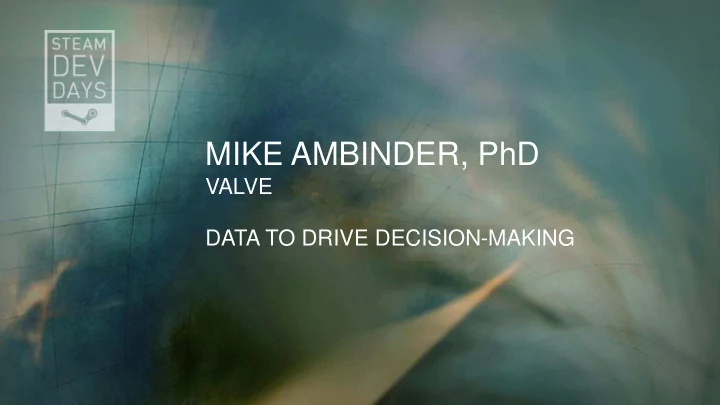

MIKE AMBINDER, PhD VALVE DATA TO DRIVE DECISION-MAKING
HOW AND WHY VALVE USES DATA TO DRIVE THE CHOICES WE MAKE
Data to Drive Decision-Making • Decision-Making at Valve • Introduction to experimental design • Data collection/analysis infrastructure • Examples — Playtesting (L4D) — DOTA 2 — CS:GO
DECISION-MAKING AT VALVE http://www.thumotic.com/seven-ways-the-red-pill-will-improve-your-life/
Decision-Making at Valve • No formal management structure • Decision-making is a meritocracy • All data is available to every employee • We just want to make the best decisions possible. • We don’t want to rely on ‘instinct’ it is fallible
Decision-Making • Explicit • Data-driven • Theory-driven • Measurable Outcomes • Iterative http://sarahmjamieson.wordpress.com/2012/06/10/the-solo-runner-quantum-meditation-5/
Explicit • What problem are you trying to solve? • Define terminology/constructs/problem space • Ask the ‘second’ question • Force yourself to be specific • Force yourself to be precise
Data-Driven • What do we know about the problem? • What do we need to know before we decide? • What do we still not know after we decide?
Theory-Driven • What does the data mean? — Is it consistent with expectations? — Is it reliable? • Model derived from prior experience/analysis • Coherent narrative • Prove a hypothesis right (or wrong) • Want result AND explanation
Measureable Outcomes • Define ‘Success’ • How will we know we made the right choice? • Know the ‘outcome’ of your decision
Iterative Gather Data Formulate Analyze Hypothesis Data
Iterative Run Experiment in TF2 Steam Run Run Experiment Experiment in CS:GO in DOTA 2
If it can be destroyed by the truth, it deserves to be destroyed by the truth. – Carl Sagan INTRODUCTION TO EXPERIMENTAL DESIGN http://www.sas.com/en_us/insights/analytics.html
THE SCIENTIFIC METHOD http://www.tomatosphere.org/teacher-resources/teachers-guide/principal-investigation/scientific-method.cfm
Experimental Design • Observational — Retrospective vs. Prospective — Correlational not causal • Experiment — Control Condition and Experimental Condition — Account for confounding variables — Measure variable of interest
Experimental Design • What have we learned? • What biases are present? • How are future experiments informed? • What other hypotheses need to be ruled out? • What should we do next?
DATA COLLECTION/ANALYSIS INFRASTRUCTURE http://dorkutopia.com/wp-content/uploads/2013/06/Servers-Server-Farm-Engine-Room.jpg
Valve Data Collection • Record lots and lots (and lots) of user behavior • If we’re not recording it, we’ll start recording it • Define questions first, then schema • Collection Analysis Communication
Data Collection - Games • OGS – Operational Game Stats • Platform for recording gameplay metrics • Kills, Deaths, Hero Selection, In-Game Purchases, Matchmaking wait times, Bullet trajectories, Friends in Party, Low-Priority Penalties, etc.
Data Collection - Games • Organizational schemas defined for each game • Data sent at relevant intervals • Daily, Monthly, Lifetime Rollups, Views, Aggregations
ValveStats
Data Collection - Steam • Steam Database – Raw data • SteamStats Database – Analysis/Summary of Raw Data • Record all relevant data about Steam user behavior
PLAYTESTING
Valve’s Game Design Process Goal is a game that makes customers happy Game designs are hypotheses Playtests are experiments Evaluate designs based off playtest results Repeat
Hypothesis Content Creation Playtesting + Game Design Feedback
Playtest Methodologies • Traditional — Direct Observation — Verbal Reports — Q&As
Playtest Methodologies • Technical — Stat Collection/Data Analysis — Design Experiments — Surveys — Physiological Measurements (Heart Rate, Eyetracking, etc.)
LEFT 4 DEAD
Enabling Cooperation • Coop Game where competing gets you killed • Initial playtests were not as enjoyable as hoped • Initial playtests were not as cooperative as hoped — Players letting their teammates die — Ignoring cries for help
Enabling Cooperation • Explicit: Players letting teammates die • Data-Driven: Surveys, Q&As, high death rates • Theory-Driven: Lack awareness of teammate location • Measurements: Surveys, Q&As, death rates • Iterative: Hypothesis: Give better visual cues to teammate location
5 Deaths in 'No Mercy - The Apartments' 4.5 4 3.5 ~40% Decrease 3 2.5 2 1.5 1 0.5 0 Pre Post
Results • Survey ratings of enjoyment/cooperation increased • Anecdotal responses decreased • Deaths decreased
Enabling Cooperation • Explicit: Players letting teammates die • Data-Driven: Surveys, Q&As, high death rates • Theory-Driven: Lack awareness of teammate location • Measurements: Surveys, Q&As, death rates • Iterative: Where else can visual cues aid gameplay?
DOTA 2
Improve Player Communication • Explicit: Reduce negative communication • Data-Driven: Chat, reports, forums, emails, quitting • Theory-Driven: No feedback loop to punish negativity • Measurements: Chat, reports, ban rates, recidivism • Iterative: Will this work in TF2? Do these systems scale? Hypothesis: Automating communication bans will reduce negativity in-game
Results • 35% fewer negative words used in chat • 32% fewer communication reports • 1% of active player base is currently banned • 61% of banned players only receive one ban
CS:GO
Weapon Balance • Explicit: M4A4 usage is high; few choices in late-game • Data-driven: Purchase rates • Theory-driven: Greater tactical choice Player retention • Measurements: Purchase rates, playtime, efficacy • Iterative: Inform future design choices Hypothesis: Creating a balanced alternative weapon will increase player choice and playtime
Results • ~ 50/50 split between new and old favorites • Increase in playtime — Conflated with other updates — Difficult to isolate • Open question as to whether or not increased weapon variability increases player retention
Where Can You Begin? • Start asking questions • Gather data — any data — Playtests — Gameplay metrics — Steamstats — Forum posts/emails/Reddit • Tell us what data you’d like us to provide
THANKS!!!
Contact Info Mike Ambinder mikea@valvesoftware.com
Recommend
More recommend